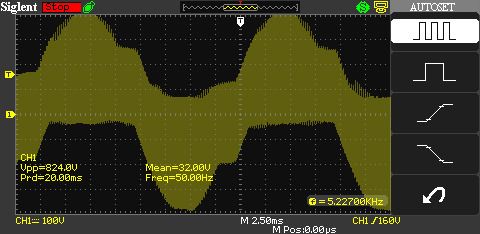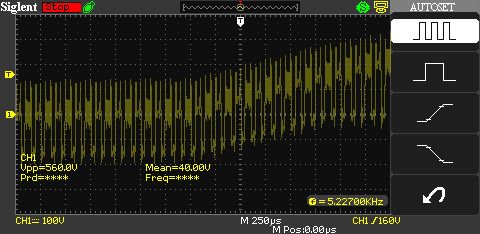There seems to be some confusion about what the output of a VFD looks like. Here is a sketch of a typical VFD output stage, essentiallly a 3-phase bridge:

The 0V line is the same as the mains neutral and the DC_BUS is the rectified mains, around 320V for a single phase input. A motor is connected the the three terminals U, V and W.
Each pair of IGBTs can be in one of four states:
Both IGBTs off – the output will float and do it's own thing
Upper IGBT on, lower IGBT off – The output will be DC_BUS, minus the Vce(sat) of the IGBT
Lower IGBT on, upper IGBT off – The output will be 0V, plus the Vce(sat) of the IGBT
Both IGBTs on – exciting stuff, as the DC_BUS will effectively be shorted. Been there, done that as a result of a software boo-boo, short circuit current was on the order of 3000A. 
Let's assume the the IGBTs are fed with 1:1 mark:space square waves, so the upper IGBT is on for t seconds while the lower IGBT is off, then vice versa. The output will be a 1:1 square wave. If this is filtered it will be a DC voltage at half the DC_BUS voltage, ie, mid-rail. This is essentially the "neutral" point of the 3-phase output. If all three arms are driven in this fashion then any motor connected will just sit there, as the same voltage will appear on each terminal of the motor, at zero frequency, and no current will flow.
Now suppose we ensure that the upper IGBT is on for longer than the lower IGBT; filtering will result in a voltage above DC_BUS/2. Similarly if the lower IGBT is on for longer than the upper IGBT the filtered voltage will be lower than DC_BUS/2.
If we're clever with the upper and lower timings we can get an output that, when filtered, looks like a sine wave. However, the output of the VFD (on V, U, W) is a PWM signal swinging from 0V to DC_BUS.. It is not a sine wave or anything like, as there is no filter on the output. Since the IGBTs are either full on or full off the dissipation in them is relatively low, compared to them being driven linearly to produce a sine wave output – essentially an audio amplifier.
So how does that explain the SoD waveform? The 0V line is not usually brought out, so I think SoD measured phase to phase. This will give a sinusiodal like waveform, albeit with the switching waveform imposed on it. The spikes and noise are a combination of two effects. One, there will be parasitic L and C which will give spikes during switching due to high di/dt and dv/dt. Second, unless one is using a high quality probe with proper "earthing", the probe itself will generate "spikes" and "noise". The bog standard ground lead you see on 99.9% of scope probes doesn't cut the mustard for high speed measurements. It has too much inductance.
Right, still got a long list of things to do this evening. The first of which is check on the medlars simmering on the hob. The plan is to make medlar jelly, but at the moment the liquid is looking like brown goo, not translucent red. 
Andrew
Jon.







